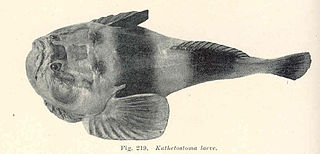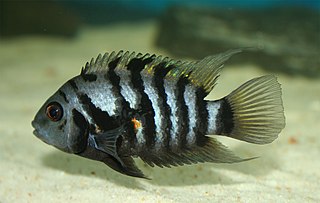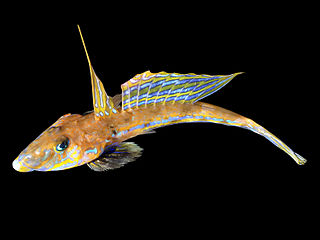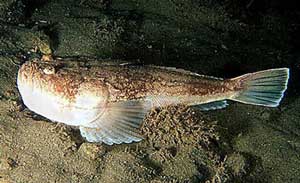The Centrophoridae are a family of squaliform sharks. The family contains just two genera and about 15 species. They are sometimes called gulper sharks, but this is also the name of a specific species in the family, Centrophorus granulosus. These are generally deepwater fish. While some, such as the gulper shark C. granulosus, are found worldwide and fished commercially, others are uncommon and little-known. Their usual prey is other fish; some are known to feed on squid, octopus, and shrimp. Some species live on the bottom (benthic), while others are pelagic. They are ovoviviparous, with the female retaining the egg-cases in her body until they hatch.

The stargazers are a family, Uranoscopidae, of perciform fish that have eyes on top of their heads. The family includes about 51 species in eight genera, all marine and found worldwide in shallow and deep saltwaters.

An electric fish is any fish that can generate electric fields, whether to sense things around them, for defence, or to stun prey. Most fish able to produce shocks are also electroreceptive, meaning that they can sense electric fields. The only exception is the stargazer family (Uranoscopidae). Electric fish, although a small minority of all fishes, include both oceanic and freshwater species, and both cartilaginous and bony fishes.

The convict cichlid is a fish species from the family Cichlidae, native to Central America, also known as the zebra cichlid. Convict cichlids are popular aquarium fish and have also been the subject of numerous studies on fish behaviour.
Deania is a genus of long-snouted, deepwater dogfish sharks in the family Centrophoridae.
The New Zealand catshark is a species of shark belonging to the family Pentanchidae, the deepwater catsharks, in the order Carcharhiniformes. This species is endemic to in the deep waters around New Zealand. Its length is up to 45 centimetres (18 in). The New Zealand catshark is a small, little-known deep water bottom shark. It is dark brown around the top with a few widely spaced pale spots, and white below. It feeds on bottom-living crustaceans. It is also completely harmless to humans.

McMillan's catshark is a species of shark belonging to the family Pentanchidae, the deepwater catsharks, in the order Carcharhiniformes. McMillan's catshark is a small, rare, and little-known deepwater shark that is endemic to New Zealand. It is found at depths of 985–1350m on the lower continental slope around New Zealand, on the West Norfolk Ridge, and off North Cape. It can grow to a length of 45 cm.

The white-bodied catshark is a catshark of the family Pentanchidae, the deepwater catsharks.

The shortnose demon catshark is a shark of the family Pentanchidae, the deepwater catsharks. This species is found only in deep water in the East China Sea. Its length is up to 40 cm. A. internatus is known only from the holotype and a paratype, both caught in the East China Sea, probably taken as bycatch in deepwater trawl fisheries. The reproduction of this catshark is oviparous.

The broadmouth catshark is a rare species of shark of the family Pentanchidae, the deepwater catsharks. The holotype and only specimen of which was taken from off Zhujiang in the South China Sea, at a depth of 913 m. Its length is around 38 cm. The broadmouth catshark's reproduction is oviparous. Considering the species is not well known, the threats are not known either but may be deepwater fisheries.

Callionymus is a genus of dragonets found mostly in the Indian and Pacific oceans with a few species occurring in the Atlantic Ocean.
Dactyloscopus is a genus of sand stargazers native to the coasts of the Americas.

Coastal fish, also called inshore fish or neritic fish, inhabit the sea between the shoreline and the edge of the continental shelf. Since the continental shelf is usually less than 200 metres (660 ft) deep, it follows that pelagic coastal fish are generally epipelagic fish, inhabiting the sunlit epipelagic zone. Coastal fish can be contrasted with oceanic fish or offshore fish, which inhabit the deep seas beyond the continental shelves.
Dactylagnus is a genus of sand stargazers, found in the eastern central Pacific and western central Atlantic Ocean.

Uranoscopus is a genus of stargazer fish from the family Uranoscopidae. The name Uranoscopus is from the Greek, ouranos, "sky" and skopein, "to watch".

Astroscopus, the electric stargazers, is a genus of stargazers, a type of percomorph fish from the family Uranoscopidae, part of the order Labriformes. The species in this genus are anatomically distinct uranoscopids, being characterized by internal nares and being the only group of marine bony fish having organs which produce electricity which are derived from the extraocular muscles. They are found on the Atlantic and Pacific coasts of the Americas.

Kathetostoma is a genus of bony fish from the family Uranoscopidae, the stargazers. They are demersal predators which are found in the western Atlantic, Pacific and Indian Oceans, with most species around Australia and New Zealand.
Kathetostoma canaster, also known as the speckled stargazer, is a ray-finned fish species described in 1987. It is native to the Eastern Indian Ocean.












